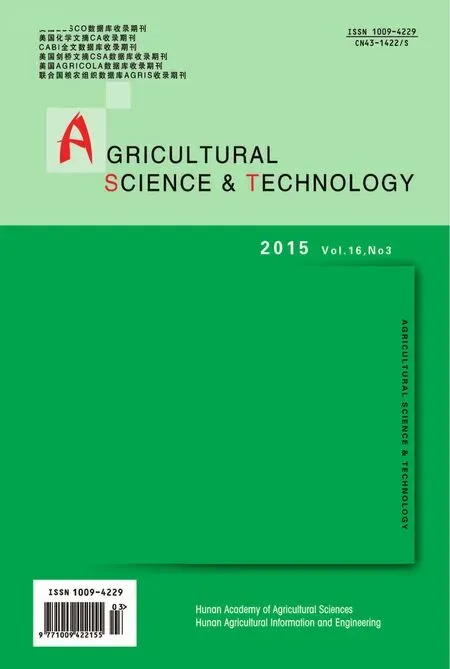Effects of Feed-grade Proteinase on the Production Performance of Piglets
Ningan MEI,Jie BAI,Xicheng SHAO,Yangping MU,Jianning DING,Guifen CHEN
1.Institute of Animal Husbandry and Veterinary Sciences (Co.,Ltd.),Ningxia Academy of Agriculture and Forestry Sciences,Yinchuan 750002,China;2.Ningxia Xiasheng Industrial Group Co.,Ltd.,Yinchuan 750002,China;3.Xiji Animal Husbandry and Fishery Technical Extension Service Center,Xiji 756200,China
As a type of endoprotease produced by submerged fermentation culture ofBacillus subtilis1398 and advanced extraction technology,feed-grade proteinase is pure natural,safe and nontoxic with strong hydrolysis ability and wide range of action,which can decompose high molecular weight proteins into peptides,amino acids and other products under certain temperature and pH conditions,thus forming a unique flavor[1].
A large number of studies have been conducted on the effects of protease.Xuet al.[2]reported that adding exogenous protease into piglet diets could reduce the influences of anti-nutritional factors in soybean meal and improve the nutritional value of soybean meal.Liet al.[3]found that adding exogenous protease into piglet diets could effectively complement the deficiency of endogenous protease in piglets,thereby improving the digestibility of protein and other nutrients in diets and enhancing anti-diarrhea capacity of piglets.
In this study,feed-grade proteinase was added into conventional diets of three-line crossbred piglets to investigate the effects of feed-grade proteinase on production performance and breeding efficiency ofpiglets,aiming at providing the reference for rational utilization of feed-grade proteinase in actual production.
Materials and Methods
Materials
ProteaseFeed-grade proteinase,with enzyme activity≥50 000 U/g,was provided by Ningxia Xiasheng Industrial Group Co.,Ltd.
Experimental animalsThirty-four 45-day-old three-line crossbred(Duroc×Landrace×Large White)piglets were selected as experimental materials.
Methods
Experiment grouping designThe experiment was carried out in Jianguo Farm of Xiji County in Ningxia Hui Autonomous Region.Single-factor completely randomized design was performed.Experimentalpiglets were randomly divided into experimental group and control group,17 piglets per group.The initial weight of piglets in experimental group and control group was(16.88±0.57)and(16.93±0.91)kg respectively,with no significant dif-ferences.
Dietary composition and nutrient levelsPiglets in control group were fed with conventional diets and those in experimental group were fed with conventional diets with addition of 0.01%feed-grade proteinase.Specific dietary composition and nutrient levels were shown in Table 1.
Daily managementThe pre-experiment period lasted 5 d and the whole experiment process lasted 30 d with free feeding and drinking.Before the experiment,pigsties were washed and disinfected;experimental piglets were administrated with anthelmintics for parasite expelling.
Determination of production performance
Experimental piglets were weighed on an empty stomach at the beginning and end of the experiment,to calculate daily weight gain,feed intake and feed conversion ratio.
Data analysisExperimental data were analyzed using biometric software.Multiple comparison tests were performed to determine the significance of differences.
Results and Analysis
Observation results
Piglets in experimental group exhibited normal defecation,healthy fur color and good mental condition with no clinical symptoms.One piglet in control group had mild diarrhea with an incidence rate of 5.88%.
Determination of weight gain
Initial weight and final weight of experimental piglets were determined,and the results were shown in Table 2.
As shown in Table 2,after addition of 0.01%feed-grade proteinase into piglet diets,daily weight gain per pigletin experimentalgroup was 6.87%higher than that in control group with significant differences (P<0.05),which indicated that adding feed-grade proteinase into diets could improved significantly weight gain performance of piglets.Moreover,feed conversion ratio in experimental group was 4.72%lower than that in control group with significant differences(P<0.05).

Table 1 Dietary composition and nutrient levels

Table 2 Statistics of experimental results

Table 3 Economic benefits in different groups during the experimental period
Economic benefit analysis
Analysis results of economic benefits in different groups were shown in Table 3.
According to analysis results of economic benefits,gross profit in experimental group was 171.99 yuan,which was 19.16 yuan higher than that in control group,with an improvement rate of 12.98%.
Conclusion and Discussion
(1)Piglets in experimental group exhibited normal defecation,healthy fur color and good mental condition without any clinical symptoms;a piglet in control group had mild diarrhea symptoms with an incidence rate of 5.88%,which indicates that adding feed-grade proteinase into diets can improve anti-diarrhea capacity of piglets.
(2)After addition of feed-grade proteinase into diets,growth rate of piglets was improved significantly with an average improvementrate of 6.87% (P<0.05).Moreover,adding feed-grade proteinase into diets can improve feed conversion efficiency and decline feed costs;in this study,average feed conversion ratio was reduced by 4.72%(P<0.05).
(3)Economic benefitanalysis shows that adding feed-grade proteinase into diets can improve significantly breeding efficiency of piglets.
[1]LING BM(凌宝明),FENG DY(冯定远),ZUO JJ(左建军).Research progress of feed proteinase(饲用蛋白酶的研究进展)[J].Feed Industry(饲料工业),2009,30(22):7-10.
[2]XU JB(胥九兵),YU XB(余晓斌),WANG LJ(王丽菊).Removal of antigen protein in soybean meal by a proteinase producingBacillus subtilisstrain(利用蛋白酶产生菌固态发酵去除豆粕中抗原蛋白)[J].Chinese Journal of Bioprocess Engineering(生物加工过程),2008,6(3):48-51.
[3]LI N(李诺),LIN C(林晨),HAN Q(韩琦).The research actuality of preventing and cure piglet diarrhea by bromelain(菠萝蛋白酶防治仔猪腹泻的研究现状)[J].Feed China(饲料广角),2004,(22):38-39.
 Agricultural Science & Technology2015年3期
Agricultural Science & Technology2015年3期
- Agricultural Science & Technology的其它文章
- Metal Contamination in Field Grown Rice
- Cytological Study on Zidao Type Cytoplasmic Male Sterile Line-Yingxiang A
- Major Cultivation Technology of HQ No.1,a New Flue-cured Tobacco Cultivar
- Design of Constructed Wetland for Treatment of Tailwater from Wastewater Treatment Plant
- The Application of Pearson Correlational Analysis Method in Air Quality Analysis of Beijing-Tianjin-Hebei Region
- Experimental Summary and Enlightenment of Urban and Rural Integration in Henan Province
